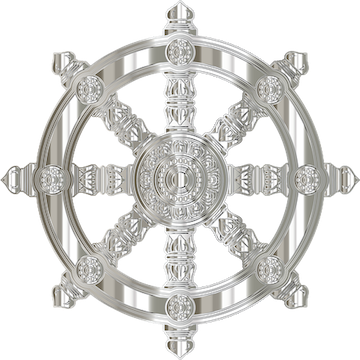The Buddhist 10 Fold Path
10. RIGHT LIBERATION

Right Liberation is the final step in this series and follows the previously discussed Right Knowledge. As we started with Right View and went through the subsequent steps on the noble Eight-fold Path, learning and investigating the Buddhist teachings is deemed one of the five kinds of wealth:

“Monks, possessing three qualities, a monk is best among devas and humans: one who has reached the ultimate conclusion, won ultimate security from bondage, lived the ultimate spiritual life, and gained the ultimate consummation. What three? (1) Right view, (2) right knowledge, and (3) right liberation.” — AN I.292
All this learning, introspection, and putting what has been learned into practice is supposed to lead to Right Liberation. The Dhamma is not just to be learned, it is to be realized. Let’s see what this means in the Buddhist context. The Anguttara Nikaya commentary has a brilliant summation of the process towards it:

“He directly knows one thing, a wholesome Dhamma, the noble path.
By means of knowledge he reaches right liberation, emancipation by the fruit of arahantship.”
Striving is an important factor in leading one towards the purity of Right Liberation. In combination with virtue, purity of mind, and right view, striving leads to emancipation from clinging of the mind [setting your mind free]:

“And what is the factor of striving for purity of liberation? That same noble disciple, possessing this factor of striving for purity of virtuous behavior, this factor of striving for purity of mind, and this factor of striving for purity of view, detaches his mind from the things that cause attachment and emancipates his mind through the things that bring emancipation. He thereby reaches right liberation. This is called purity of liberation.” — AN II.196
Right Liberation also has as it’s aim the uprooting of the causes of ignorance (avijja), here called the ‘splitting’ of ignorance:

“Just as the warrior splits a great body, so too the noble disciple has right liberation. The noble disciple with right liberation has split the great mass of ignorance.” — AN II.202
A common analogy of Nibbana in the Buddhist teachings is the reaching of the ‘other shore’ and ‘going beyond’. This in contrast to the ‘near shore’ that pertains to mundane living in the cycle of birth, death, and suffering. The near shore is considered wrong liberation, and the other shore being Right Liberation, while the noble Ten-fold Path is the raft to take one from the near shore to the other shore:

“Wrong liberation is the near shore, right liberation the other shore.
When the Dhamma is rightly expounded, those people who practice accordingly, are the ones who will go beyond the realm of Death so hard to cross [into the deathless].” — AN V.232
Knowing and realizing are two different things, and spiritual experience without the uprooting of the causes of suffering is not equal to Right Liberation:

“And what, monks, is liberation more spiritual than the spiritual? When a monk whose taints are destroyed reviews his mind liberated from lust, liberated from hatred, liberated from delusion, there arises liberation. This is called liberation more spiritual than the spiritual.” — SN IV.237
Right knowledge (samma-nana) is the wisdom of the [10-fold] path of attainment, and right liberation (samma-vimutti) is the liberation from the defilements that occurs through right knowledge. The process bound together can be explained as the taintless liberation of mind, and this liberation is realized through wisdom. Right Liberation is also referred to as Deliverance and/or Emancipation, giving it a more spiritual character.
In conclusion, I offer you the pen-ultimate reference to anyone who thinks that Buddhism merely teaches for one to become a better human being, and that there are no further spiritual aims to be had:

The Nikayas are Buddhist books that form the earliest Buddhist canon of scriptures containing the teachings of the Buddha.

First of all, it really helps to have these books in digital form, so you can search for a particular word easily and be able to read how it is mentioned and in what context it is placed in the teachings of the Buddha.
The following English translations of the primary texts are available and used:
- The Connected Discourses of the Buddha: A Translation of the Samyutta Nikaya (SN)
- The Long Discourses of the Buddha: A Translation of the Digha Nikaya (DN)
- The Middle-Length Discourses of the Buddha: A Translation of the Majjhima Nikaya (MN)
- The Numerical Discourses of the Buddha: A Translation of the Anguttara Nikaya (AN
B. The Virtue and Moral Discipline aggregate of training
- Right livelihood (samma-ajiva)
C. The Concentration aggregate of training
- Right effort (samma-vayama)
- Right mindfulness (samma-sati)
- Right concentration (samma-samadhi)
The Ten-fold Path consists of two additional ‘folds’:
- Right knowledge / wisdom (samma-nana)
- Right liberation / release (samma-vimutti)
- AN = Anguttara Nikaya,
- DN = Digha Nikaya,
- MN = Majjhima Nikaya,
- SN= Samyutta Nikaya); followed by book number in roman capitalized numerals and verse number (for example, AN I.30 = Anguttara Nikaya book 1 verse 30).
Note: Quotations follow the PTS (Pali Text Society) naming and numbering format:
- Right View
- Right Intention/Thought
- Right Speech
- Right Action
- Right Livelihood
- Right Effort
- Right Mindfulness
- Right Concentration
- RIGHT KNOWLEDGE / WISDOM
I will flag comment spam at 1% strength. If you keep on spamming my post I will flag you at 100%. I don't care if you have limited English abilities write a couple sentences about this article, no copy-paste please. I will flag: one sentence comments, links to your blog and begging for up-votes and follows. Also I will flag comments that have nothing to do with my blogs article. I will also check your comment section to see if you have been comment spamming on other blogs.


 A link to My Blog
A link to My Blog
This is probably the hardest of the paths to translate into western thinking, for we have no analogies.
Right liberation is a freedom so profound that one can never be locked up again.
The newest propaganda is instantly seen through
The warlords will come to arrest him and either -
When someone offers a false love, a binding love, there is no purchase in his heart.
He cannot be stabbed in the back, for he is not tied to the hopes that would blind him from his supposed friend's deeds.
This is true freedom, it is worth the journey.
I have said to my Buddhist friends I want to be able to walk through heaven and hell with a clear mind. Heaven and hell representing my reactions to what I like and dislike. I haven't gotten to that place yet but after years of practice how I react to sense data has gone from knee jerk reactions when I first started to backing off and taking some time before I take action.
The writings are taken from a monks point of view. What is missing is the teachings of Buddha to laypeople. That is why I like Mahayana Buddhism, it teaches the Bodhisattva path and has many teachings for the layperson. I was lucky to have found a Theravada vipassana meditation teacher SN Goenka who taught lay people the path of freedom through wisdom and insight. @builderofcastles you do speak of true freedom. thank you <3
You would think most folks would have the right intentions. But I suppose free will can create selfishness. Thanks for sharing @reddust.
Free will covered in ignorance is blind.
It all fits together in the end. I get it. Sadly many folks are too selfish and held hostage by the MdDonalds mentality to take the time to gain this understanding. Thanks @reddust.
I don't know if these teachings will ever be popular or trendy. I am okay with that, for people like me who want to know why their choices have brought them so much suffering and suffering to the people they love, hopefully they will investigate for themselves and find the right path out of self caused suffering.
Most folk, including me 25 years ago want to take a chill pill or listen to some self help guru, or eat a special diet...hahaha, that didn't work for me but study, meditation, cleaning up my life has helped. I am not a saintly person but I have faith from experience the methods and lessons Buddha taught do work.
@reddust, I appreciated all of your effort here. This time another Buddhism speech you explained nicely. Absolutely I didn't mind you're Buddhist. You told me it from your last post comment. Then you told me that, you want to see Sri Lanka's old temples and ancient places. I posted it before 8 hours. I guess you satisfy after watch it and I'll post more after the another trip very soon.
Thank you @moniristi
All correct paths are the symbol of peace.The main motto of achieving success in the right path.
Thank you @shihabieee
Well job
Right liberation is for me an experience that is deep, meaningful and liberating. I don't know when I'll achieve it, but I do know if I keep trying, I'll get close to it. I am not a Buddhist, but I believe in a lot of what Buddhism states and the eightfold noble path too. A lot of the teachings are similar to those of Islam.
You would think most folks would have the right intentions. But I suppose free will can create selfishness. Thanks for sharing @reddust.
Very good .
freedom.
Very good post boss@reddust......